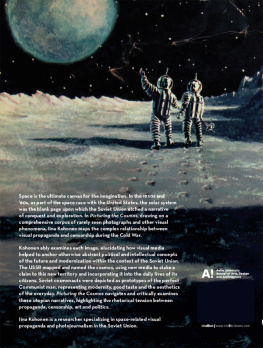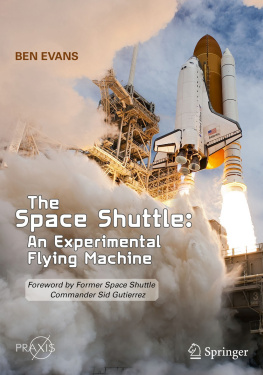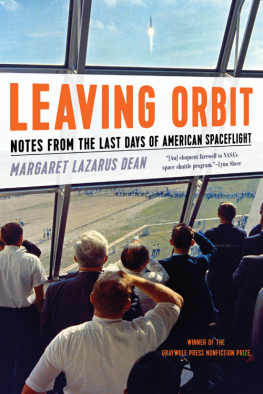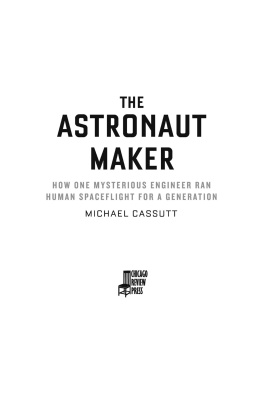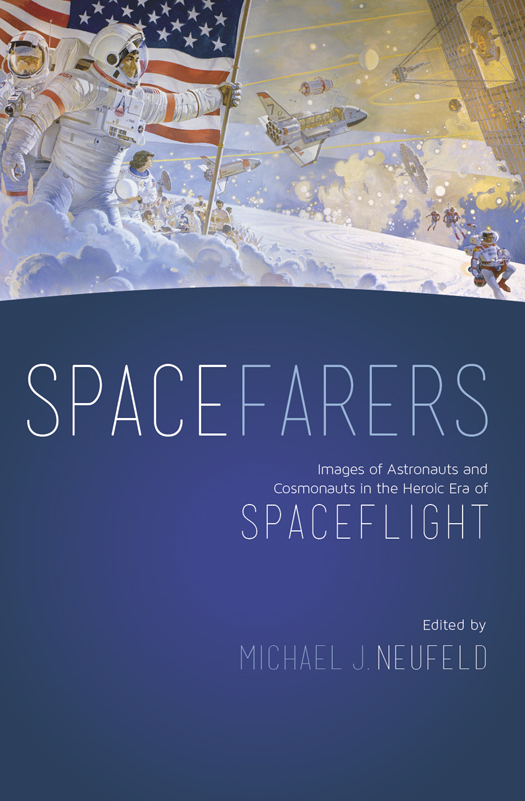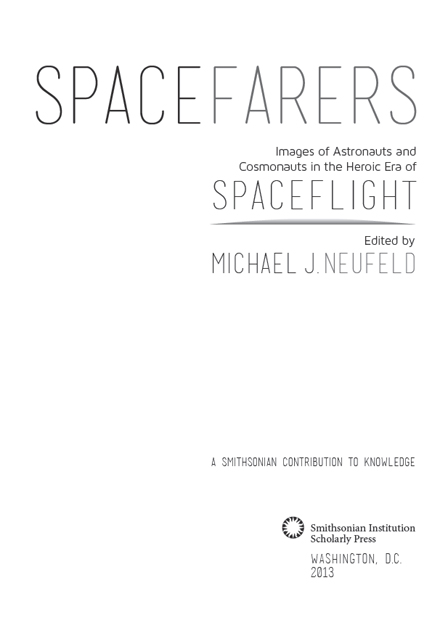Published by SMITHSONIAN INSTITUTION SCHOLARLY PRESS
P.O. Box 37012, MRC 957
Washington, D.C. 20013-7012
www.scholarlypress.si.edu
Compilation copyright 2013 by Smithsonian Institution
Text of is in the public domain. The rights to all other text and images in this publication, including cover and interior designs are owned by the Smithsonian Institution, contributing authors, or third parties and may not be reproduced, stored in a retrieval system, or transmitted in any form or by any means, electronic, mechanical, photocopying, recording, or otherwise, without the prior permission of the publisher.
Dust jacket image: Opening the Space Frontier, The Next Giant Step, mural by Robert T. McCall in the NASA Johnson Space Center, Houston, Texas, 1979. Courtesy McCall Studios, http://www.mccallstudios.com/.
Library of Congress Cataloging-in-Publication Data:
Spacefarers : images of astronauts and cosmonauts in the heroic era of spaceflight / edited by Michael J. Neufeld.
p. cm. (A smithsonian contribution to knowledge)
Includes bibliographical references.
ISBN 978-1-935623-19-9 (alk. paper)
eBook ISBN: 978-1-935623-25-0
1. Astronautics in mass media. 2. AstronauticsSocial aspects. 3. Astronautics and state. 4. AstronautsUnited States. 5. AstronautsSoviet Union. I. Neufeld, Michael J., 1951 II. Series: Smithsonian contribution to knowledge.
P96.A792S63 2013
629.45dc23
2013000432
v3.1
CONTENTS
I NTRODUCTION
Michael J. Neufeld
Setting the Scene for Human Spaceflights:
Men into Space and The Man and the Challenge
Margaret A. Weitekamp
Capsules Are Swallowed:
The Mythology of the Pilot in American Spaceflight
Matthew H. Hersch
Nostalgia for the Right Stuff:
Astronauts and Public Anxiety about a Changing Nation
James Spiller
The Fiftieth Jubilee:
Yuri Gagarin in the Soviet and Post-Soviet Imagination
Andrew Jenks
Astronauts and Cosmonauts into Frenchmen:
Understanding Space Travel through the Popular Weekly Paris Match
Guillaume de Syon
They May Remake Our Image of Mankind:
Representations of Cosmonauts and Astronauts in Soviet and American Space Propaganda Magazines, 19611981
Trevor S. Rockwell
Bringing Spaceflight Down to Earth:
Astronauts and The IMAX Experience
Valerie Neal
Youve Come a Long Way, Maybe:
The First Six Women Astronauts and the Media
Jennifer Ross-Nazzal
Warriors and Worriers:
Risk, Masculinity, and the Anxiety of Individuality in the Literature of American Spaceflight
Margaret Lazarus Dean
Introduction
Michael J. Neufeld
This volume had its origins in a conference held at the headquarters of the National Aeronautics and Space Administration (NASA) in Washington, D.C., in April 2011. The conference 1961/1981: Key Moments in Human Spaceflight commemorated the fiftieth anniversary of the first human spaceflights by the Soviet Union and the United States, and the thirtieth anniversary of the first space shuttle launch, which took place exactly twenty years after Yuri Gagarins pioneering orbit on April 12, 1961. This book, however, does not present most of the papers that were given, nor are all the chapters based on papers read at the conference. Rather, in consultation with the NASA History Program Office, I decided that the one coherent theme that emerged from several papers was the image of astronauts and cosmonauts in the media, state propaganda, and popular culture. Social and cultural history of the first three decades of human spaceflight was prominent at the conference, reflecting the maturation of the space history subdiscipline and its growth beyond the traditional technical, programmatic, and political history narratives. Stephen Garber of NASA History and I therefore asked a couple of the participants to revise their papers or submit new papers to fit the theme of the images of astronauts and cosmonauts, and we solicited one new article to cover at least one theme that had been relatively neglected, the women astronauts of the shuttle program.
Marie Lathers, the author of Space Oddities: Women and Outer Space in Popular Film and Culture, 19602000, has asserted that for the United States (and one might add for the rest of the world), 1961 was a fundamental rupture , when real men went into orbit.archetypes, such as heroic aviators and explorers. In the Soviet Union, because of obsessive secrecy, that fame appeared at the moment when their launch was announced; in the United States, celebrity began two years before the first flights, with the introduction of the seven Mercury astronauts to the media. Both corps of spacefarers were represented in their respective media and government propaganda as shining examples of masculinity and patriotism representing all the best values of their competing cold war systems.
The missions of the first astronauts and cosmonauts opened a period I call the heroic era of human spaceflightboth for the media representation of their image and the actual danger of their occupation. Seven of them were killed in ground tests or spaceflights between 1967 and 1971, and others died in plane crashes and training accidents throughout the sixties. The superpower race for firsts, culminating in the Apollo 11 Moon landing in July 1969, set the agenda and increased the risk. The United States built one-man Mercury, two-man Gemini, and three-man Apollo spacecraft, plus a two-man lunar lander; the Soviet Union created the one-cosmonaut Vostok capsule, modified it as the two- or three-passenger Voskhod, then built a Soyuz spacecraft that could carry up to three. Soviet engineers modified the Soyuz to loop around and orbit the Moon, plus a one-man lander to get to the surface, but no Soviet cosmonaut ever flew them. In the aftermath of the American triumph, the Soviet Union denied its lunar plans and shifted to space station missions, whereas the United States, after six landings, retreated to low Earth orbit. It used Apollo spacecraft to get to one temporary station, Skylab, and to link up with a Soviet Soyuz in 1975, during a brief period of dtente. In 1972, NASA had been given the go-ahead to build a reusable space shuttle, carrying up to seven or eight astronauts, in order to make Earth orbit missions and a permanent space station easier, but it did not fly until 1981.
When the heroic era ended is arguable. Two shuttle accidents in 1986 and 2003 demonstrate that human spaceflight has never become routine. However, for the purposes of this book we will define it as ending with the Challenger disaster of 1986 (although two chapters do look beyond that point). After Challenger, space travel resumed its trajectory toward becoming frequent and anonymous; the end of the cold war in 1989 resulted in the demise of the Soviet Union and the rise of cooperative rather than competitive human space programs (the Chinese excepted).
As human spaceflight objectives became more ambitious and spacecraft technology improved, scientists and women (and women scientists) were added to the ranks of spacefarers, beginning with the flight of Valentina Tereshkova in 1963, although it would be nineteen years before another woman flew. That changing crew composition, especially in the 1980s, inevitably complicated the Dissent and satire regarding the space program in the Eastern Bloc, however, had to be confined to jokes and the work of unofficial artists. In the West, by contrast, a free press and media could create alternative or unflattering images of astronauts, for example, in Hollywood movies, especially as the cold war consensus eroded. Nonetheless, the heroic vision of spacefarers remained dominant in the media, even when few in the public knew their names anymore.


